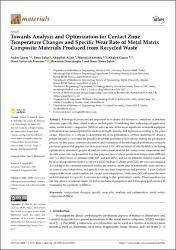| dc.contributor.author | Gunes, Aydin | |
| dc.contributor.author | Salur, Emin | |
| dc.contributor.author | Aslan, Abdullah | |
| dc.contributor.author | Kuntoglu, Mustafa | |
| dc.contributor.author | Giasin, Khaled | |
| dc.contributor.author | Pimenov, Danil Yurievich | |
| dc.contributor.author | Duzcukoglu, Hayrettin | |
| dc.contributor.author | Sahin, Omer Sinan | |
| dc.date.accessioned | 2022-03-04T10:46:30Z | |
| dc.date.available | 2022-03-04T10:46:30Z | |
| dc.date.issued | 2021 | en_US |
| dc.identifier.issn | 1996-1944 | |
| dc.identifier.other | PubMed ID34576369 | |
| dc.identifier.uri | https //doi.org/10.3390/ma14185145 | |
| dc.identifier.uri | https://hdl.handle.net/20.500.12573/1230 | |
| dc.description | This study was supported by the Scientific and Technological Research Council of Turkey (TUBITAK) [Project Number: 113M141] and Konya Technical University OYP Projects Coordination Unit [Project Number: 2014-OYP-86]. | en_US |
| dc.description.abstract | Tribological properties are important to evaluate the in-service conditions of machine elements, especially those which work as tandem parts. Considering their wide range of application areas, metal matrix composites (MMCs) serve as one of the most significant materials equipped with desired mechanical properties such as strength, density, and lightness according to the place of use. Therefore, it is crucial to determine the wear performance of these materials to obtain a longer life and to overcome the possible structural problems which emerge during the production process. In this paper, extensive discussion and evaluation of the tribological performance of newly produced spheroidal graphite cast iron-reinforced (GGG-40) tin bronze (CuSn10) MMCs, including optimization, statistical, graphical, and microstructural analysis for contact zone temperature and specific wear rate, are presented. For this purpose, two levels of production temperature (400 and 450 degrees C), three levels of pressure (480, 640, and 820 MPa), and seven different samples reinforced by several ingredients (from 0 to 40 wt% GGG-40, pure CuSn10, and GGG-40) were investigated. According to the obtained statistical results, the reinforcement ratio is remarkably more effective on contact zone temperature and specific wear rate than temperature and pressure. A pure CuSn10 sample is the most suitable option for contact zone temperature, while pure GGG-40 seems the most suitable material for specific wear rates according to the optimization results. These results reveal the importance of reinforcement for better mechanical properties and tribological performance in measuring the capability of MMCs. | en_US |
| dc.description.sponsorship | Turkiye Bilimsel ve Teknolojik Arastirma Kurumu (TUBITAK) 113M141
Konya Technical University OYP Projects Coordination Unit 2014-OYP-86 | en_US |
| dc.language.iso | eng | en_US |
| dc.publisher | MDPIST ALBAN-ANLAGE 66, CH-4052 BASEL, SWITZERLAND | en_US |
| dc.relation.isversionof | 10.3390/ma14185145 | en_US |
| dc.rights | info:eu-repo/semantics/openAccess | en_US |
| dc.subject | temperature changes | en_US |
| dc.subject | specific wear rate | en_US |
| dc.subject | analysis and optimization | en_US |
| dc.subject | metal matrix composites (MMCs) | en_US |
| dc.title | Towards Analysis and Optimization for Contact Zone Temperature Changes and Specific Wear Rate of Metal Matrix Composite Materials Produced from Recycled Waste | en_US |
| dc.type | article | en_US |
| dc.contributor.department | AGÜ, Mühendislik Fakültesi, Makine Mühendisliği Bölümü | en_US |
| dc.contributor.institutionauthor | Gunes, Aydin | |
| dc.identifier.volume | Volume 14 Issue 18 | en_US |
| dc.relation.journal | MATERIALS | en_US |
| dc.relation.tubitak | 113M141 | |
| dc.relation.publicationcategory | Makale - Uluslararası - Editör Denetimli Dergi | en_US |


















